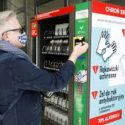
It’s no secret that many objects that we use in our daily lives resulted from innovations in times of crisis and change. We are surrounded by things which have an inception in war, space exploration, and simple mistakes. With the world gripped by the deadly COVID-19 pandemic, we are forced to change and adapt at a rapid pace. Masks are commonplace, protective panels have been put in places of business, and work is being conducted more online than ever. What changes will remain post pandemic? What innovations will result from this time? Let’s explore the most promising changes that have resulted from the past year.
- Mask Vending Machines
Many countries and major US cities have implemented the use of vending machines in order to provide PPE access to all citizens. The use of a pre-pandemic convenience combined with mask distribution has posed the question of how the focus on public health will translate to a post-pandemic life. Will we continue to wear masks in America like people do in Japan? Will hand sanitizer, wipes, and masks become a public good?
While many want to move on from pandemic life and go back to our previous normal as quickly as possible, it would be a waste to abandon the way in which we have adapted existing technology to fit a specific need. Now that we are aware that vending machines can be functional in many different ways, and offering more free hygiene products is effective, we can continue to improve the quality of life for many, even after the pandemic.
- mRNA Vaccines
Messenger RNA, or mRNA vaccines have never been approved for widespread use, and now, they face their first test with COVID-19. mRNA and traditional vaccines differ in a few different ways. While traditional vaccines are created by growing virus cells in a lab over the course of months, an mRNA vaccine is made by scanning DNA to encode the antigen of an infectious agent in a single week. Further, mRNA vaccines pose far less of a biological risk, as only small quantities of the original virus are needed, unlike the large quantity of virus that would need to be grown for a single traditional vaccine.
Outside of production, these two vaccines function in extremely different manners in terms of disease prevention. Previously, vaccines would inject a virus’ antigen into the body, to which cells would act and begin to develop an immune response, subsequently preparing the immune system for the next time it would be exposed to the virus. mRNA simplifies this process, and delivers the RNA instructions for responding to the virus directly to the cells. The immune system is entirely prepared for exposure to the virus without ever needing to be exposed in the first place.
If the COVID-19 mRNA vaccine is a success, it could fundamentally change the ways that we deal with pathogens. mRNA vaccines are far more predictable and standardized than previous vaccines. Rather than spending time in trial and error in production, the mRNA creation process boils down to encoding the virus’ information, which can be done within a single week.
While this new technology now faces the challenge of proving its efficacy, safety, and receiving government approval, the innovation which it represents will impact disease prevention for many years to come.
- Working online
Over the past few years, I’ve watched my dad drive an hour to go to his office every morning. He’s always told me that he’d rather be home, that he could do his job so much better from the comfort of our house. Now that he’s forced to work from home, he finds so much more joy in his work. And he’s not the only one.
COVID-19 has taught us that our attachment to the traditional work environment is entirely unfounded. There are so many people that can easily work from home that had been previously dragged into a dim, dark office building day after day. There are also so many people who require in person work. Why have we been treating these starkly different groups exactly the same? We can easily translate public health precautions to those who are required to work in person, and allow others to stay home. As this has been done over the course of the pandemic, it has been proven that providing this choice benefits worker’s physical health and mental health, taking away the stress of being forced to enter a dangerous world, while preventing virus exposure.
Once we are able to move on with our lives in a post pandemic world, we will face the question of if we should even try to go back to our old normal. It’s a waste to drag people to an office when they don’t want to, and would rather be at home. We can benefit the environment by keeping cars off of the road, we can give more leisure time to workers by taking the time of a commute away. By giving workers more choice, we will drastically improve the quality of life for many, and it would be a tragedy to not do so.
Ultimately, COVID-19 has, and will continue to rock the foundations of what we consider normal. Our daily lives have changed so much over the past year, and as we reach the other side of this ongoing tragedy, we will carry with us the lessons and innovations that COVID-19 has spurred. Hopefully, despite the pain and suffering that we have experienced, we will be able to make the world a better place with what we have learned.
